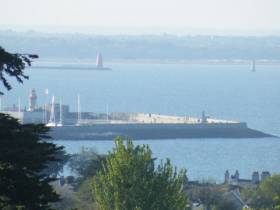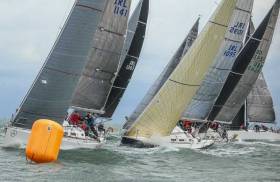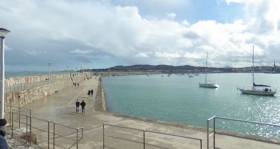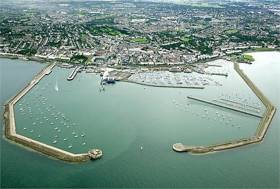Displaying items by tag: Dun Laoghaire Harbour
'Moosmie' Leads Water Wag Series (Start Video Here!)
For the second week in a row, the wind in Dun Laoghaire blew from the north. This time the wind of 12 -15 knots kicked up quite a chop within the harbour, which some competitors found challenging. In the130th season for the class, twenty-three Water Wags turned up for the second of three matches for The Newsom Memorial Cup (div. 1A), Hilpotsteiner Tankard (div 1B), and Phyllis Cup (div. 2).
At the start, many Wags found themselves behind the committee boat at the starboard end of the start line. No so, Barbara, Pansy, Moosmie and Mary Kate who hit the line perfectly. It turned out that tide would not be a significant factor in the race, but due to a small bias in the start line, it did pay to start at the starboard end of the line. Start video courtesy of Jenifer Hudson below:
Due to the size of the waves coming through the harbour mouth, crews had to work had to keep momentum in their Water Wags, and to minimise heeling. At the second windward mark, close to the harbour mouth the order was Moosmie, Barbara, Swift, and Tortoise. However, when Tortoise gybed soon afterwards, the helmsman slipped, and the inevitable result was water pouring over the leeward gunwale. Once spinnakers were hoisted and set they provided additional stability to the Wags, and the ability to surf the waves. On the following round the order had changed to Moosmie, Swift, and Barbara. Competitors were getting more used to the conditions after that with fewer place changes.
 David MacFarlane in Moosmie, is the winner of both races of the series
David MacFarlane in Moosmie, is the winner of both races of the series
At the finish the order was:
1st – 15, Moosmie, David MacFarlane.
2nd - 38, Swift, Guy & Jackie Kilroy.
3rd. - 41, Mollie, Annalise Murphy.
4th. -33, Eva, Dermot O’Flynn
5th - 8, Barbara, Ian and Judith Malcolm
6th. - 3, Pansy, Vincent Delany & Charles Pearson.
7th. – 6, Mary Kate, Ian & Jenny Magowan. (Winner div 2).
8th. – 4, Vela, Philip & Katie Mayne.
9th. - 40, Swallow, David & Anne Clarke. (Winner div 1B).
10th. - 46, Mademoiselle.
11th. – 18, Good Hope.
12th. - 47, Peggy.
13th. - 34, Chloe.
14th. – 32, Skee.
15th. - 10, Sprite.
16th. - 31, Polly.
17th. – 26, Nandor.
18th. - 44, Scallywag.
19th. -16, Penelope.
20th. - 43, Freddie.
21st. - 45, Mariposa.
RET. – 36, Little Tern.
RET. – 42, Tortoise.
Overall Moosmie is in first place with Swift in second place with only one more race in the series. Link to the overall results here
Launch of DLR Spring into Heritage Programme of Events
#DLRHeritage - Easter is over but there’s plenty more to do with this year’s Spring into Heritage (28 April-18 June) programme organised by Dun Laoghaire-Rathdown County Council.
Beginning next Monday, the DLR Heritage programme offers a variety of events and free guided walking tours. Among them are those with direct maritime themes connected with Dun Laoghaire Harbour which this year celebrates its Bicentenary.
Given this special 200th anniversary, guided walking tours will prove to be particularly apt as they delve into the magnificent engineering of the historic harbour built using granite from nearby Dalkey. The harbour originally began with construction in 1817 of a single pier, the East Pier.
Nearby to the popular East Pier, there will be also be guided tours of the National Maritime Museum housed in the former Mariners Church located next to the DLR Lexicon Library.
On the other side of the harbour, just beyond the West Pier, there will also be tours of Seapoint Martello Tower built to defend a possible Napoleonic invasion. The stone-cut structure affords a wonderful panorama with views sweeping across Dublin Bay.
Why not take a visit to the Dalkey Castle & Heritage Centre. Tours explore and explain the 15th century medieval fortified towerhouse, where cargoes were once stored from ships that anchored in Dalkey Sound which then acted as the main port for Dublin.
Other none coastal venues including tours of historic houses set in parkland throughout the borough are available. Noting some events require pre-booking. For more details including downloadable leaflet click here.
'Freedom of Entry' Conferred to Naval Service As Flagship Visits Dun Laoghaire Harbour
#FreedomShip – At a special public event held in Dun Laoghaire Harbour a conferral of ‘Freedom of Entry’ was presented to crew of LÉ Eithne on behalf of the Irish Naval Service, writes Jehan Ashmore.
In the presence of ambassadors and officials among them representing the UK, Italy and China, An Cathaoirleach of Dún Laoghaire-Rathdown County Council, Councillor Cormac Devlin presented the honorary conferral to Lt Cdr. Brian Fitzgerald, commander of LÉ Eithne. Cdr Hugh Tully was also in attendance on behalf of Defence Forces Chief of Defence, Vice Admiral Mark Mellett.
Also at the lunchtime ceremony where members of the public along with local schoolchildren waving the tricolour. The proceedings included a crew party standing to attention with the backdrop of LÉ Eithne berthed behind at St. Michaels Pier. Also sharing the pier was seasonal Dublin Bay excursion boat, St. Bridget.
The ‘Honorary Freedom of Entry to the Council’ was awarded by Dun Laoghaire-Rathdown County Council to the Irish Naval Service in recognition of the humanitarian mission 'Operation Pontus' that was carried out in the Mediterranean on behalf of the people of Ireland and the EU. The conferral was the first ever presented by DLRCC and that of any council.
Master of ceremonies, RTE's Mary Kennedy hightlighted that LÉ Eithne along with fleetmates during Operation Pontus played a significant role in the rescue of 15,000 migrants and refugees. Lt Cdr. Brian Fitzgerald commented LÉ Eithne is to be deployed again to the Mediteranean in a month’s time so to resume humanitarian duties. This he added though is subject to Government approval.
The ceremony also provided an opportunity to mark a more solemn moment as a minutes silence took place to honour those lost in the Irish Coastguard Helicopter tragedy of R116 off Blacksod, Co. Mayo.
Overall command of the search remains with the Coast Guard that had involved LÉ Eithne appointed as On Scene Co-ordinator (OSC) of the operation. This role was transferred to L.É. James Joyce but this OPV has been recently relieved by class leadship L.É. Samuel Beckett in the ongoing operations at Blackrock Island Lighthouse.
On a more joyous note, at the end of proceedings in Dun Laoghaire, the Army No.1 Band led a crew parade from the Harbour Plaza. This saw the parade head up along Marine Road to outside the Town Hall of Dun Laoghaire-Rathdown.
For the summer of 2017 at least, it looks as though Dun Laoghaire Harbour is going to remain free of the threat of the installation of a new liner berth. W M Nixon reckons this provides a unique opportunity for town and harbour to come together as they may have done once upon a time, but have failed to replicate for many years. He provides the background, and makes some suggestions.
The trouble with Dun Laoghaire is that there’s nowhere else quite like it. There isn’t really a truly comparable totally artificial harbour anywhere else on this scale set on the edge of a city, in the midst of an area of general affluence and recreational expectations. It is arguably unique. Nowhere in the world is there a similar setup from which those who hope to manage Dun Laoghaire Harbour effectively might learn lessons on how to make a viable proposition of their port and its future.
Although the original asylum harbour was built by engineer John Rennie and others in majestic style, at the time it had only one simple purpose – to provide shelter for unwieldy sailing ships when Dublin Bay was storm-beset and Dublin Port with its very shallow bar entrance was inaccessible.
The original plans show a sublime indifference to the existence of the little old harbour of Dunleary immediately to the west of the proposed location of the vast new structure. And the little port there has long since disappeared under high value property development to an extent which the early harbour planners cannot have begun to imagine.
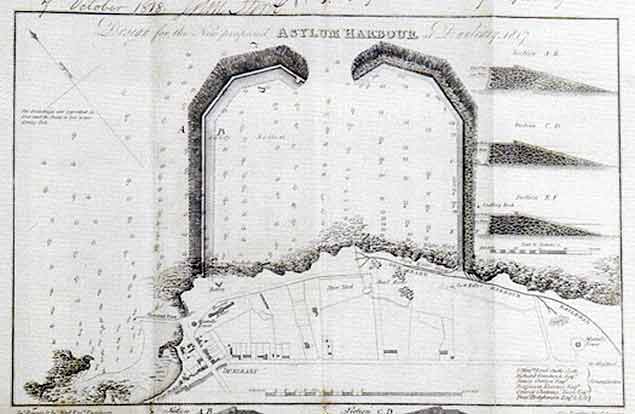 The original plan for the new harbour deliberately excluded the little old harbour of Dunleary to the west, as the new harbour was not intended to provide ship to shore access.
The original plan for the new harbour deliberately excluded the little old harbour of Dunleary to the west, as the new harbour was not intended to provide ship to shore access.
For the idea was not that this would be a port. On the contrary, it would only be a place of temporary shelter in which vessels of importance – particularly those on British government business - would be secure until conditions improved. It was not envisaged that there would be any significant shoreside contact during their short time in what very quickly became Kingstown Harbour.
For of course, no sooner was a harbour under construction, than a town began to develop beside it. It was notoriously un-planned, so much so that fifty years later a critic mocked its name of Kingstown – conferred with a Royal visit in 1821 – by pointing out that far from being a King’s town, it was rather more of a republic of selfish building anarchy.
At the beginning – which we now date to 200 years ago, with the first stone officially laid on May 31st 1817 - significant shoreside development had not been intended. As historian Hal Sisk has pointed out, at no time did the official plans include anything so basic to a proper port town such as warehouses, let alone shipyards or even boatyards. But the basic existence of the harbour in its earliest form by the late 1820s saw the first regatta being staged in 1828. Recreational sailing and the harbour have been intertwined ever since. And the irresistible growth impulse of Kingstown was underlined by the arrival of the railway from Dublin in 1834.
 The eastern part of Kingstown harbour at its Victorian high point as a ferry port. The area in the centre, immediately east of Carlisle Pier, will be used for berthing Classic and Traditional Vessels in July during the Volvo Dun Laoghaire Regatta 2017.
The eastern part of Kingstown harbour at its Victorian high point as a ferry port. The area in the centre, immediately east of Carlisle Pier, will be used for berthing Classic and Traditional Vessels in July during the Volvo Dun Laoghaire Regatta 2017.
We take that date of 1834 for granted, but in terms of world railway history, it was very early indeed. And it in turn roped Kingstown into other unplanned developments. As long as the entrance to Dublin port remained dangerously shallow, Kingstown had all the advantages for the rapid development of the cross channel ferry trade. It was all done initially on an ad hoc basis, but it worked for the ferries, while the already proven attractions of the place as an innovative recreational sailing location made it central to world sailing development by the 1860s and 1870s.
So for most of the two hundred years whose history we’ll be celebrating in July, Dun Laoghaire/Kingtown has been struggling with the fact that the basic concept of the harbour - which by its monumental and historic scale still dictates what can be done with it today – was planned with virtually no attention paid to the sea/land interface.
 Despite the restrictions on waterfront space, Kingstown Harbour had become a leading sailing centre by the latter half of the 19th century, as shown in this painting by Richard Brydges Beechey of a Royal St George YC regatta in the 1870s. Courtesy RStGYC
Despite the restrictions on waterfront space, Kingstown Harbour had become a leading sailing centre by the latter half of the 19th century, as shown in this painting by Richard Brydges Beechey of a Royal St George YC regatta in the 1870s. Courtesy RStGYC
Ideally, when the harbour was being built, at least as large an area ashore should have been set aside on the adjacent land to provide for a proper harbour town. But nothing remotely like this was done, and the railway was brought in by the easiest possible shoreside route, thereby putting another barrier between the growing town and the harbor. As a result, the town/harbour relationship has always been problematic. This is particularly so when allied to the fact that areas of conspicuous affluence are almost cheek by jowl with what seem like semi-deprived areas by comparison.
On top of all this, there’s the eternal problem of paying for the harbour’s maintenance. It was superbly built in the first place, but it would be an insult to those early engineers, and their incredibly industrious workers labouring under dangerous conditions, if we failed to maintain the harbour properly in a manner which respects its original concept, while continuing to give it validity for contemporary life.
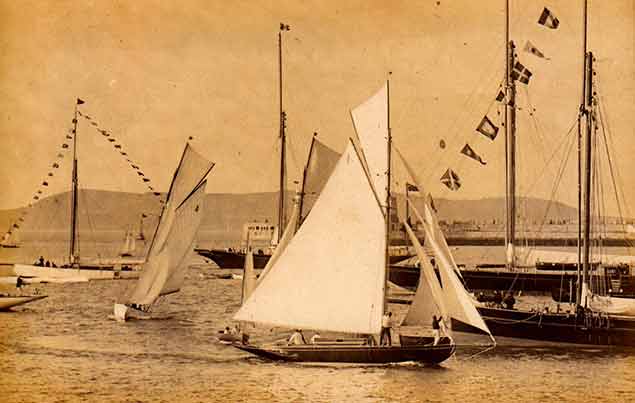 The good old days……..It is the summer of 1901, and the Viceroy Lord Dudley is finishing in-harbour after threading his course through moored yachts to take the win with his new Dublin Bay 25 Fodhla in company with some boats of the new version of the Water Wag class. In second place in the DB 25s is Nepenthe (No 4, Sir H Robinson). Both Dublin Bay 25s were built in Dun Laoghaire by J E Doyle. Photo courtesy Theo Harris
The good old days……..It is the summer of 1901, and the Viceroy Lord Dudley is finishing in-harbour after threading his course through moored yachts to take the win with his new Dublin Bay 25 Fodhla in company with some boats of the new version of the Water Wag class. In second place in the DB 25s is Nepenthe (No 4, Sir H Robinson). Both Dublin Bay 25s were built in Dun Laoghaire by J E Doyle. Photo courtesy Theo Harris
Since the ferries pulled out to re-locate entirely in Dublin Port, taking their guaranteed income stream with them, the struggle has gone on between those who wish to develop any potential the harbour might have for a cruise-liner port of call, and those who feel it should be seen more as a sort of maritime version of the Phoenix Park. They envisage it as a vast breathing space, ultimately maintained by public funds if there’s a shortfall between the income generated by recreational use, and the routine maintenance and administration expenses.
But for the moment, any further development has been postponed awaiting a court case. In it, the point is to be made that making the harbour accessible to functioning liners, with emission-spewing machinery working on a 24/7 basis, will have the effect of polluting the atmosphere in and around the harbour - particularly along the East Pier, the regular promenade for thousands of Dubliners in search of fresh air.
Apparently this point had not been made in the original hearings, so the result is that for the summer of 2017, Dun Laoghaire Harbour will continue as it is at present, with new areas of open sailing space available following the removal of the Stena installations.
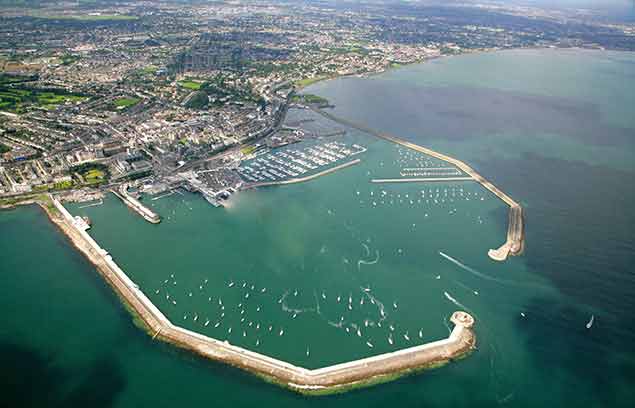 Dun Laoghaire Harbour as it is at present, offering ample space for finishing races. Photo Peter Barrow
Dun Laoghaire Harbour as it is at present, offering ample space for finishing races. Photo Peter Barrow
In the circumstances, surely this is a golden opportunity for the organisers of the Volvo Dun Laoghaire Regatta 2017 to take a look at any section of their enormous and very varied entry list, and select classes which could be given the treat of having at least one of their races finish within the harbour?
Increased ferry traffic was just one of the reasons why the racing for larger craft was obliged to take place outside the harbour. For national and international events, the obsession with committee boat starts and finishes further dictated the move seaward. In Dun Laoghaire, it meant that the connection between the town and active highly-visible sailing became more tenuous than ever.
Yet if we look back to old photos of Dun Laoghaire when it was in the full pomp of its years of Kingstown yachting glory, it was the action in the harbour which brought the whole show to life, and gave everyone a sense of involvement. So let’s hope that the powers-that-be realize that the deferring – permanently we hope – of the proposed liner berth offers an opportunity. Liners Out, Sailboats Back In – that could be the slogan for 2017.
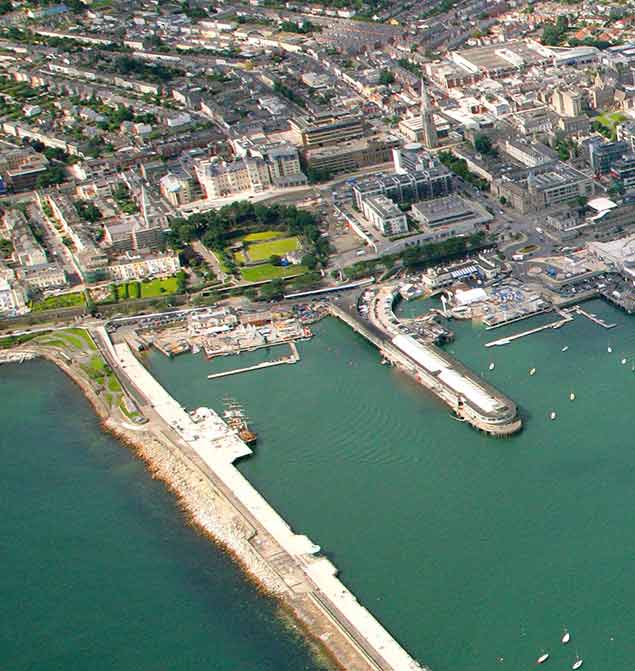 The accessible area off the National YC (photo pre-Lexicon) will provide berthing for Classics and Traditional craft Photo: Peter Barrow
The accessible area off the National YC (photo pre-Lexicon) will provide berthing for Classics and Traditional craft Photo: Peter Barrow
Of course we don’t expect that the really hot classes will agree to finish in-harbour. But there’s something about the Volvo Dun Laoghaire Regatta which attracts a significant segment of participants for whom a bit of fun is central to the sport, and indeed there are many who think that the real sport would be in having to make an in-harbour finish.
The Classics and Traditional Craft will be playing a significant role in this special year. In addition to a dedicated berth with lots of pontoon length being provided for them in the area off the National Yacht Club, the word is that on one day at least, they will have their start in the harbour, highly visible from the East Pier in the area immediately beyond the Carlisle Pier.
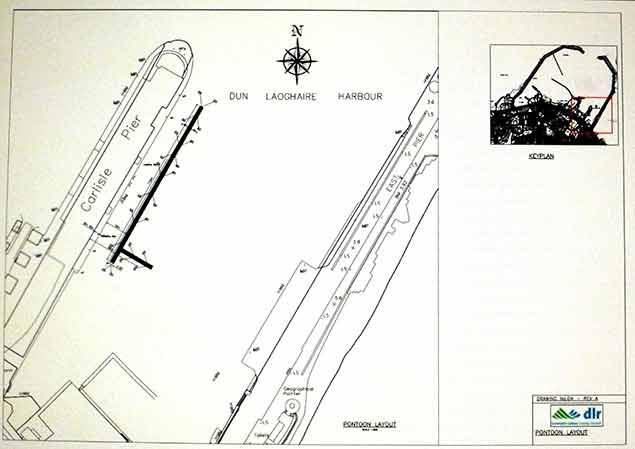 Plan of the proposed pontoon location off the National YC to berth “boats with bowsprits”.
Plan of the proposed pontoon location off the National YC to berth “boats with bowsprits”.
With boat types such as Drascombes coming as a fleet, the notion of the potential accessibility of sailing could be given an enormous boost. What could seem more approachable than the presence of Drascombe man Jack O’Keefe and his mates in friendly competition within the harbour, along with all sorts of other exotic craft such as the Shannon One Designs?
 Jack O’Keeffe’s Drascombe is usually seen in distant ports of the west… .Photo: Pierce Purcell
Jack O’Keeffe’s Drascombe is usually seen in distant ports of the west… .Photo: Pierce Purcell
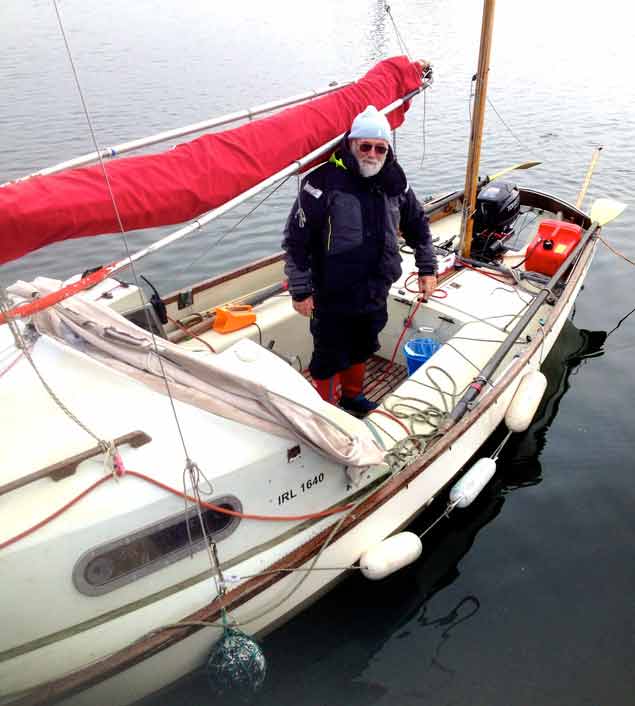 ….but in July 2017 he and his fellow enthusiasts are headed for Dun Laoghaire’s Bicentenary. Photo: Pierce PurcellNot least of such exotica will be the Water Wags, more than ever a part of Dun Laoghaire sailing and Dun Laoghaire Harbour. At this week’s launching of Volvo Dun Laoghaire Regatta ing of Volvo Dun Laoghaire Regatta 2017 in the National Maritime Museum, there was something very touching about the way that the only surviving boat of the original Water Wag class of 1887, the world’s first One Design, had been moved to the centre of the former Mariners Church. The little boat was there in pride of place as the great and the good of Irish sailing networked with each other as plans were revealed of the remarkable amount of behind-the-scenes work that goes into ensuring that this largest of all Irish sailing events runs smoothly.
….but in July 2017 he and his fellow enthusiasts are headed for Dun Laoghaire’s Bicentenary. Photo: Pierce PurcellNot least of such exotica will be the Water Wags, more than ever a part of Dun Laoghaire sailing and Dun Laoghaire Harbour. At this week’s launching of Volvo Dun Laoghaire Regatta ing of Volvo Dun Laoghaire Regatta 2017 in the National Maritime Museum, there was something very touching about the way that the only surviving boat of the original Water Wag class of 1887, the world’s first One Design, had been moved to the centre of the former Mariners Church. The little boat was there in pride of place as the great and the good of Irish sailing networked with each other as plans were revealed of the remarkable amount of behind-the-scenes work that goes into ensuring that this largest of all Irish sailing events runs smoothly.
In the 1890s, there must more than a hundred of these little boats in and around the Greater Dublin area. Even Erskine Childers, with part of the summer of 1894 unfilled in his plans, arranged to have one carted up into the Wicklow Hills to the mountain lake of Lough Dan near the house of his mother’s family, so that he could go sailing when the mood took him.
Yet with the new larger boats introduced in 1900, the little old double-enders just faded away. Fortunately, someone noticed that an odd-looking little canoe-sterned dinghy with a centreplate case on the beach at Malahide was one of the original Water Wags. She was being used for the occasional fishing trip, and it had been a long time since the centreplate had been used for sailing.
She was saved in the nick of time, and is now kept fully rigged in the Maritime Museum. But as the Wag Class historian Vincent Delany assured me at the Volvo reception, she really is absolutely the only surviving original example of a boat which was once so numerous, and fundamental to the global development of sailing.
 The original Water Wags of 1887, the world’s first One Design class. Despite being numerous in the 1890s, the original boat on display in the National Maritime Museum in Dun Laoghaire is now thought to be the only survivor of this historic type.
The original Water Wags of 1887, the world’s first One Design class. Despite being numerous in the 1890s, the original boat on display in the National Maritime Museum in Dun Laoghaire is now thought to be the only survivor of this historic type.
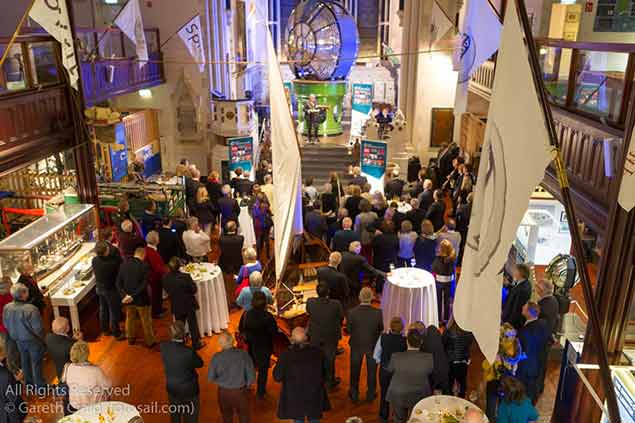 At the heart of things. The sole surviving Dublin Bay Water Wag of 1887 in the midst of the Volvo Dun Laoghaire Regatta 2017 launch reception in the National Maritime Museum on Wednesday night.
At the heart of things. The sole surviving Dublin Bay Water Wag of 1887 in the midst of the Volvo Dun Laoghaire Regatta 2017 launch reception in the National Maritime Museum on Wednesday night.
#dlharbour200 - To mark the 200th anniversary of Dun Laoghaire Harbour (formerly Kingstown) a summer of celebrations have been organised. The Dun Laoghaire Harbour Bicentenary Steering Group has announced its programme of activities to coincide with the milestone event.
The Opening Ceremony will be officiated by President Michael D Higgins & the groups Patron Minister Mary Mitchell O Connor on 31st May. Other featured events include an International Harbour Food Festival featuring over 25 unique vendors (4th & 5th June), The Kingstown 200 Classic Boat Race (8th July) and a live Viking Invasion re-enactment with longboats as seen on the hit TV Show ‘Vikings’ (20th August).
100,000 visitors are expected to visit the harbour this summer to participate in the free public events. The Dun Laoghaire Harbour Company in collaboration with a range of local stakeholders have put in place a schedule of exhibitions, workshops, lectures and events to mark the Bicentenary. For further information visit www.dlharbour200.ie
Gerry Dunne, CEO of Dun Laoghaire Harbour Company: said “the programme of events throughout the summer reflects the cultural and historical role the harbour has played not just in Dun Laoghaire but in its wider environs over the past 200 years”. Thanking all those who worked tirelessly on the project, Mr Dunne said “the Bicentenary will bring a welcome boost to the local economy and reinforce the sense of public pride in one of the country’s greatest landmarks”.
#CruiseBerth - An environmental Dublin Bay group’s challenge over an €18 million terminal berth for cruise ships at Dún Laoghaire Harbour writes The Irish Times will be heard later this year at the Commercial Court.
The Save Our Seafront (SOS) group opposes the planned development for reasons including that it was allegedly approved without proper identification and assessment of its impact on the environment and on recreational users of the harbour, including small boat users and on regattas.
An environmental impact statement failed to consider that people walk on the pier to enjoy fresh air and the view of the Dublin mountains, and to consider the effects on their enjoyment if a large cruise ship is obscuring the view and “emitting diesel and sulphur fumes”, the group said.
Potential Impact
It also claims the potential impact on marine mammals, including otters and the Minke whale, was inadequately assessed.
Mr Justice Brian Cregan was told on Monday the sides had agreed the challenge, brought against An Bord Pleanála with Dún Laoghaire Harbour Company as a notice party, could be heard by the Commercial Court. The judge said the case was suitable for the court and fixed it for hearing on October 10th.
The harbour company sought to have the case fast-tracked for reasons including it regards the successful development of the cruise terminal berth as “an important element” in securing the port’s financial future, and to replace the loss of revenue resulting from the cessation of ferry services.
While it had hoped to have the berth open in time for the 2018 cruise season, construction had been delayed as a result of the case, it said.
For more on the story including the Habitats Directive and Rockabill to Dalkey Island special area of conservation, click here.
UCD Ball Set To Bring 7,000 Students To Dun Laoghaire Harbour This April
#UCDBall - Dun Laoghaire Harbour is set to host the revived UCD Ball this April.
A total of 7,000 tickets will be made available to students across the capital for the event, scheduled for the former HSS Ferry Terminal on Friday 28 April, as the University Observer reports.
More than 20 artists will perform across two stages at the ball, which will also feature a fun fair and a ‘gourmet food yard’ amid ‘a festival-like atmosphere’.
However, the venue remains subject to licence, and public submissions and/or observations can be made to Dun Laoghaire-Rathdown County Council up till this Friday 17 February.
Council Confirms Risk Assessment On Dun Laoghaire Harbour Transfer
#PortTransfer - The Dun Laoghaire-Rathdown County Council (DRCoCo) executive will undertake a full risk assessment into the transfer of ownership of Dun Laoghaire Harbour to the local authority, it has emerged.
The assessment process will aim to identify the best governance model for the harbour, following a meeting last month at which councillors unanimously agreed “serious risks” had been raised in the due diligence report into the harbour company’s position as commissioned by the council.
Following this assessment, a further report setting out the risks will be brought to the council along with an executive recommendation for the Minister for Transport based on the findings of both reports.
It’s also expected that the risk assessment may involve an engineering assessment of some aspects of the harbour’s infrastructure to determine whether there are liabilities beyond the scope of the original due diligence report.
DLRCoCo adds that no further commend will be made until the independent risk assessment is completed.
Transfer of Dún Laoghaire Harbour: Councillors’ Concerns At Liabilities
#PortTransfer - County councillors writes The Irish Times from all the main parties of Dún Laoghaire-Rathdown have expressed concern at potential financial liabilities involved in taking over responsibility for Dún Laoghaire Harbour.
The debate on due diligience issues as Afloat previously covered took place at a council meeting on Monday (last night). Councillors unanimously agreed “serious risks for the local authority” had been raised in a due diligence report commissioned by the council into the position of Dún Laoghaire Harbour Company.
Under the provisions of the Harbours Act 2015, (see National Ports Policy) responsibility for the harbour is due to be transferred from the Department of Transport to the local authority.
‘Urgent need’
However, Fianna Fail councillor Mary Hanafin said the due diligence report had identified “an urgent need for a risk assessment” in almost every area of the harbour company’s operations.
She said issues were raised about pension liabilities, legal costs, ownership of assets and liability for the repayment of grants which had been paid to the harbour company.
She told the meeting the grants could be as high as €112 million, and “the liabilities for clawback are absolutely potentially enormous”.
Fellow Fianna Fáil councillor Shay Brennan said taking over the harbour company could see its debts transferred to “every household between Dún Laoghaire and Dundrum”.
Fine Gael councillor John Bailey said the council wanted democratic control over the harbour, but not the liabilities of the harbour company - the scale of which he said was unknown.
He called for certified, audited accounts from the harbour company. “There is no way we are taking on this liability, I want the harbour but this is an absolute joke,” he said.
“Where are the audited accounts for 2015?”
Cllr Barry Ward of Fine Gael called for the dissolution of the harbour company before responsibility for the harbour is transferred to the council.
He said the council did not want a subsidiary company, because this would prevent “any oversight and governance” by the elected members.
He said the harbour company should be dissolved before the harbour comes under democratic accountability.
People Before Profit councillor Melisa Halpin also expressed concern over the due diligence report, saying councillors had been waiting 20 months to find out what the issues were.
She said there were “major questions” which remained to be asked in a risk assessment.
For more on the story including 'favouring dissolution' as discussed in the council chamber, click here.
Dun Laoghaire Harbour Due Diligence Report Set For Debate
#DLHarbour - Councillors are set to debate a report that identifies issues with the ownership of key parts of Dun Laoghaire Harbour ahead of its transfer to the local authority.
According to The Irish Times, the council-commissioned due diligence report notes “ownership-related issues” with St Michael’s Pier, the former home of the Stena HSS ferry and a focal point for development under the Dun Laoghaire Harbour Masterplan.
These developments include a proposed berth for cruise liners that was approved in restricted form by planners in November, but currently faces the prospect of a High Court challenge by local environmental group Save Our Seafront, as reported yesterday on Afloat.ie.
The report also queries the valuation of certain property assets around the harbour, as well as a potential deficit in its pension fund — and debt to the European Union over Government grants.
Dun Laoghaire-Rathdown County Council is scheduled to debate the due diligence report this coming Monday (9 January), though the harbour’s chief executive Gerry Dunne said it contained “no surprises”.
The Irish Times has more on the story HERE.




























